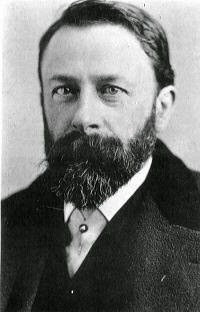With the millions of bytes of internet storage dedicated to the work of Albert Bierstadt, there is little I can say here about him that wouldn’t be said better elsewhere, what I will do is collect a few of his works here in order that I can easily scroll through them when I need a quick reminder of the quintessence of the Dusseldorf School.
 |
| Albert Bierstadt January 7, 1830-February 18, 1902 |
Albert Bierstadt was born in Germany in 1830, but his family moved to Massachusetts soon after. He later made a return trip to study art the in Dusseldorf under Emanuel Leutze (Washington Crossing the Delaware fame) before coming back and becoming one of the more theatrical members of the informal Hudson River School of painters. His paintings are lavish, glowing, and imposing. Giant works filled with ominous light and shadows, if they were not landscapes they could safely be called larger than life.
 |
| A Rustic Mill |
Bierstadt’s Rustic Mill painting is what I mean when I say quintessence of Dusseldorf style. It has a dark (albeit warm) autumnal palette, super tight composition that steers your eye to the center of the business, and glaze; actually glaze upon glaze used to give more play to the light and the dark. This picturesque view of a mill is far from the “typical” Bierstadt finery as seen in the literally enormous landscapes below.
|

|
| Lake Tahoe |
 |
| Among the Sierra Nevada Mountains |
 |
| Looking Down the Yosemite Valley |
 |
| The Rocky Mountains: Lander’s Peak |
A brief break in the action here to mention that this catches a trading scene that was hinted at but never fully captured by Alfred Jacob Miller (remember we talked about him and Drummond’s hunting expedition a couple posts ago). This 6′ x 10′ (186.7cm x 306.7cm) painting sold in 1865 for $25,000. When you get over the $25K price tag in Civil War dollars, look again at the size of this thing: Six feet tall by 10 feet wide. What seems like minutiae is in fact fairly detailed and integral part of Bierstadt’s theatrical label. More subtle are the details in perhaps his most famous(?) painting, and I will end with it
 |
| Storm in the Rocky Mountains, Mt. Rosalie. |
Here in all its light and dark ominous and promising romantic glory is a enigmatic mountain peak festooned with threatening clouds. Bierstadt was accompanying an expedition in 1863 when they named this peak after Fitz Ludlow’s (the expedition leader) soon to be ex-wife. Rosalie divorced Fitz after the expedition ended and married Bierstadt (why isn’t this a movie yet?).
 |
Rosalie Osborne Ludlow Bierstadt |
The storm over Mt. Rosalie piece is even larger than the Lander’s Peak canvas measuring in at nearly 8′ x 10′ (actually it is 83″ x 142.5″ (210.8cm x 361.3cm)) and contains a mind boggling level of detail. Here is where digital scans have actually aided the eye of the artists. If you open the image up as orignal size you can scroll through and see the highly detailed wild grape(?) vines, indian camp, and a riderless horse running from a horseless rider. The beauty (literally and figuratively in this case) of these immense creations lie in not only how they were made, but how they were exhibited. These would have been installed in an exhibit hall (sometimes only one would make up an entire gallery) with benches installed so that viewers could sit and ponder the moral meaning of the work. The details would have been enjoyed with nothing less than opera glasses. Small scenes would be encapsulated within the field of view of such devices, just as if you were sitting on a nearby peak watching the scene live.
Most people, however, encountered his works as chromolithographic (and other styles) of illustration in magazines. He was always aiming for government patronage as well as painting for a market. He lived long enough to see his high style go out of favor and criticized for the very romance that it was lauded for when he started. Always conscious of money and living well Bierstadt applied for patents and stayed aware of trends even when not participating in them. He and his brother ran a photography company and many of his paintings are influenced by the stereoscopic images they created. Many of his images have definite foregrounds, midgrounds, and backgrounds that worked in more or less this manner: Photo–>Painting–>Woodcut trying to capture all one scene.
His home/studio burned in 1882 and he left for Europe looking for investors in his idea of a portable darkroom on a collapsable railroad car. His wife died the following year and left him in a sad state of affairs until he remarried and traveled Eastern Europe through Turkey and thereabouts researching for a grand painting that would be marketed for the upcoming celebration of Christopher Columbus’ 1492 trip (1892) and the American Exposition of 1893.
 |
| The Landing of Columbus |
The Columbus piece wasn’t that well received and didn’t aid Bierstadt’s bad final years. In the 1890s he was nearly bankrupt and was forced to sell 150 of his paintings to remain solvent. A casualty of changing American tastes (towards French impressionism) Bierstadt died in 1902, but has left up with some of the grandest–in size and execution–images of the American West which fully supported the vision of Manifest Destiny and the great wealth of the golden lands that he painted.









